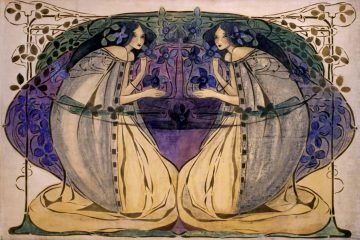Cynthia Green at JSTOR Daily:
 Most people have heard of Art Nouveau, but few remember two of the most influential figures in its conception. (No, not Gustav Klimt.) They were a pair of sisters named Margaret and Frances MacDonald, who, along with their Glasgow School of Art classmates Charles Rennie Mackintosh and Herbert MacNair, comprised the Glasgow Four. Art Nouveau wouldn’t be what it is without them.
Most people have heard of Art Nouveau, but few remember two of the most influential figures in its conception. (No, not Gustav Klimt.) They were a pair of sisters named Margaret and Frances MacDonald, who, along with their Glasgow School of Art classmates Charles Rennie Mackintosh and Herbert MacNair, comprised the Glasgow Four. Art Nouveau wouldn’t be what it is without them.
Straddling the turn of the twentieth century, from roughly 1890 to 1914, a new kind of art emerged in Europe and America. It used linear, plant-like forms, and drew from science, nature, mythical history, gender, and modernity for inspiration. People called it, simply, Art Nouveau. (Literally, new art.) The Glasgow Four were in art school as Art Nouveau was taking shape. They drew from Victorian Puritanism and Celtic Spiritualism and created ground-breaking pieces. Elongated bodies and a characteristic dreamy palette are ever-present. Colors are light, neutral, metallic, natural and mythical at the same time. And yet, there are touches of modernity, like geometric symmetry and the use of squares.
more here.
